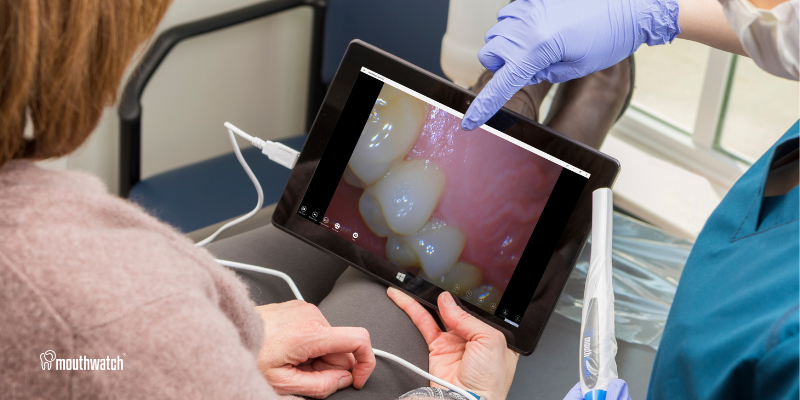
Integrating intraoral cameras into your practice workflow can revolutionize patient education and communication, treatment acceptance, and overall practice profitability. Here’s what Dr. Raymond Frye of One Dental Pacific Northwest experienced after implementing MouthWatch Intraoral Cameras:
“We simply introduced MouthWatch Intraoral Cameras for each of our four hygienists, and our office production skyrocketed by $150,000 in the first month alone. The entire team was amazed at how effortless the cameras were to incorporate into our daily routine, and their tremendous impact educating patients about their dental concerns had on case acceptance rates and revenue growth.”
– Dr. Raymond Frye of One Dental Pacific Northwest
The Power of Visual Evidence
What enables a simple intraoral camera to unlock such transformative results for a practice? By providing vivid visual evidence that truly allows patients to “see for themselves,” these cameras empower practitioners to improve patient communication, craft compelling case presentations, and foster long-term, trusting relationships with their patients.
Improve Patient Communication
Dental concepts and treatment needs can often seem abstract and complex when described verbally to patients. By combining your explanations with intraoral images that clearly illustrate conditions, you provide patients a clear window into their own oral health. This allows them to grasp the reality of their situation and genuinely understand your recommended treatment plan with confidence.
Craft Compelling Case Presentations
With intraoral camera images fully integrated into your imaging software, creating patient education materials and treatment plan presentations takes just a few clicks. Dentists can simply capture images during routine examinations, then easily compile them into visually-impactful explanations. These visuals deeply engage patients in their own care journey by making abstract treatment plans tangible and approachable.
Foster Patient-Provider Trust
Perhaps one of the most powerful applications of intraoral imaging is the ability to cultivate long-term patient motivation by documenting their treatment progress over time using “before and after” image sequences. Patients can witness healing and improvements in their oral health with their own eyes after following through with your recommended treatment. This tangible, visual proof of your services’ impact helps build patient confidence, trust in your expertise, and commitment to following through on future treatment plans.
Key Features for Intraoral Cameras
When looking to add intraoral imaging to your practice, you’ll find no shortage of options on the market today. Intraoral cameras are available at virtually every price point, from just a few hundred dollars to several thousand dollars. With so many options available at varying price points, carefully evaluating a camera’s features and capabilities is critical to maximize your investment impact. Prioritize solutions with these key features and criteria:
User-Friendly, Ergonomic Design
Seamless integration into your existing clinical workflow is essential for intraoral cameras. Look for lightweight, ergonomic handpiece designs. Since you’ll likely be using them with every patient, a lightweight camera is essential for minimizing strain throughout the day. Intuitive single-handed controls directly on the camera should enable effortless image capture, no matter how you’re holding the camera.
High-Quality Images
To ensure the intraoral images you’re capturing are truly effective for patient education and documentation, prioritize cameras that capture high-quality images and offer proper lighting for the oral cavity environment. Clear, in-focus images are a must to capture and clearly identify conditions like cracks, decay, defective fillings and more.
Adequate lighting is also crucial, as the mouth presents a unique challenge with shadows and angles. Intraoral cameras designed specifically for dentistry should include multiple LED light sources positioned to evenly illuminate every surface from multiple angles. This ensures minimal hot spots, glare, or shadows – providing a clear, properly exposed view.
Seamless Integration With Imaging Software
Having your intraoral camera integrated with your existing imaging software helps streamline your digital workflow and saves a bunch of time in the long-run. Identify cameras that easily integrate with your radiography, charting, and patient management systems out of the box. This eliminates any tedious manual importing/exporting of images between programs. Responsive manufacturer support is also critical to resolve any hurdles during setup or long-term operation.
Cost-Effective for Multi-Operatory Scaling
Equipping every operatory with intraoral imaging capabilities doesn’t have to break the bank for your practice. Evaluate solutions offering multi-camera packages and discounts designed to help you achieve a rapid return on investment through elevated case acceptance and production. Solutions like MouthWatch’s Intraoral Cameras offer multi-camera discounts for as low as $269 per camera and provide crystal-clear image quality at price points tailored for easy practice-wide scaling.
Free Lifetime Support
As with any technology investment, longevity is key. Choose intraoral cameras backed by comprehensive manufacturer support that covers everything from initial setup/training to unlimited ongoing technical assistance and loaner camera services. Having access to an expert ensures your intraoral camera keeps capturing the images you expect with minimal disruptive downtime year after year.
By strategically implementing the right intraoral imaging solution tailored to your needs, your dental practice can unlock new potential for patient engagement, communication, and sustainable practice growth.
